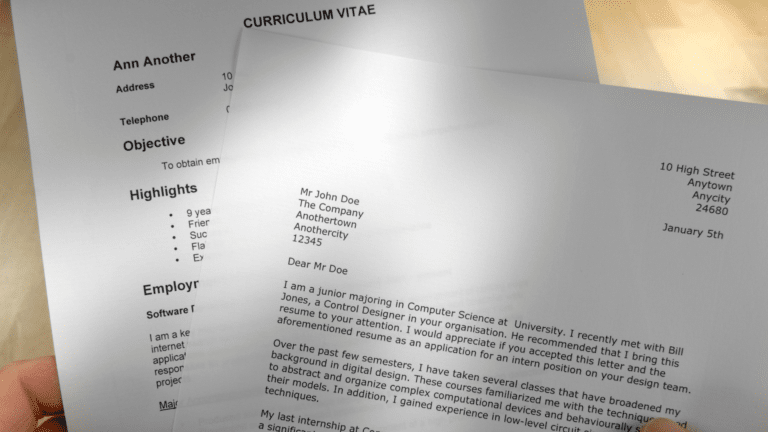Sending your two-week notice letter is not always the easiest thing to do. Once you send it to your current employer, it means you acknowledge the end of your tenure and the start of a new path in your career.
The key to writing your two-week notice is to be clear and concise, particularly with your tentative last day of work and your reason for leaving the company.
This article will walk you through the key points to remember when writing your advance notice, complete with a couple of two-week notice letter templates to use as your reference.
Key Takeaways
- A two-week notice letter is similar to a resignation letter. The difference is that the notice focuses on explaining the remaining responsibilities to accomplish before your last day at work.
- Writing a two-week notice entails clarity in terms of the date when your resignation is in effect, as well as expressing gratitude to your former employer.
- It is important to remain professional and respectful when composing your two-week notice letter to ensure a peaceful transition to your new career.
Should You Give Your Two-Week Notice?
Legally speaking, you’re not required to send a two-week notice letter because there are no federal or state laws requiring you to do so.
But if you have an existing employment contract, then you must check which terms apply in case you decide to leave the company.
Giving your two-week notice letter is done as a courtesy and respect to your current employer. Your advanced notice also depends on the kind of job or position you will be leaving.
If you are leaving a managerial position or a role that requires a unique set of skills, then it is only appropriate to give your employer enough time to find a suitable replacement.
There are also instances wherein sending an advanced notice of your resignation isn’t necessary, particularly if you are an at-will employee.
Employment contracts and fixed compensation packages do not apply to at-will employees, which means your employer can terminate your employment at any time.
How to Write a Two-Week Notice Letter in 5 Steps
Understandably, learning how to write a good two-week notice letter can be tricky.
To make the process easier, we’ll walk you through the ideal two-week notice letter format below:
#1. Address the Letter
The first step is to address the letter to your immediate supervisor or manager. For individuals in a managerial position, you may address your two-week notice to the HR manager.
A simple ‘Dear [Manager’s Name]’ or ‘Hello [Supervisor’s Name]’ is a good start to your letter. It’s direct, with just the right touch of endearment.
#2. State Your Resignation
Next, go straight to the point and explain that you are writing the letter to inform them of your decision to resign from the company. Don’t forget to provide the date of your final day at work.
Meanwhile, specifying your reason for leaving on your notice depends on you.
Adding a description of your departure from the company is more typical in a resignation letter, whereas a two-week notice letter often contains the remaining responsibilities you plan to fulfill before your final work day.
If you choose to provide a brief explanation of your resignation, make it concise and direct. For instance, you can say that you have decided to seize an opportunity to advance your career in a different environment.
#3. Show Gratitude
After stating your reason for resigning and the date of your last day at work, you should also express your gratitude and appreciation to your current employer. Let them know that you are thankful for the opportunities and experiences that they have given you.
You can also take this opportunity to share some of the things that you liked or enjoyed most while working for the company.
#4. List the Next Steps
Before ending your two-week notice letter, provide additional details on the next steps you intend to fulfill during your last two weeks in the company. For example, you can assure your employer that you will fulfill the remaining tasks on your to-do list.
You can also offer to help during the transition by recommending potential candidates or assisting in the onboarding process.
#5. Conclude the Letter
Finally, once you’ve fulfilled steps one through four, you can conclude or end your two-week notice letter. Use formal terms such as ‘Sincerely’ and ‘Respectfully’ to maintain a professional tone.
Next, put your full name as the sender of the letter. If you are sending a printed resignation notice, you can add your signature to the space at the top of your name.
Two-Week Notice Letter: 3 Examples
In this section, we’ve provided some carefully crafted two-week notice letter examples to use as your reference:
#1. Example 1: Simple and Direct
| Dear [Manager’s Name],
This letter serves as my official two weeks’ notice of resignation. My last day will be on [Date]. The decision to leave the company has not been an easy one for me. Thanks to the opportunity you have provided me, I was able to hone my skills and advance my career. Unfortunately, I believe that this is the end of the journey for the [Company Name] team and me. To help you during this transition, I plan to fulfill all my pending work on or before my last day at work. If there is anything else that I can do to be of assistance, please let me know. Once again, thank you [Ma’am/Sir]. It’s been an honor working alongside you and the team. I wish the company and everyone behind it more success in the years to come. Sincerely, [Your Name] |
#2. Example 2: Grateful and Endearing
| Dear [Manager’s Name],
I am writing this two-week notice letter to inform you of my decision to resign as a [Position in the Company] at [Company Name]. My last day of work will be on [Date]. While this was not an easy decision for me, I would like to let you know that I will always be grateful for everything you have taught me during my tenure. I would not have reached this far in my career without your guidance. That said, I am happy to assist you during this transition. Please don’t hesitate to let me know how I can be of help. Thank you, and I wish the company all the best. Sincerely, [Your Name] |
#3. Example 3: Optimistic and Appreciative
| Dear [Manager’s Name],
I am writing this letter as my two-week notice of resignation. My last day of work is on [Date]. I would like to take this opportunity to express my heartfelt gratitude to you and to the company for providing me with the guidance and opportunities I need to be the best I can be in my field of work. But, as they say, all good things must come to an end to make way for a better opportunity. That said, I believe I am ready to take on a new journey in my career. If there is anything I can do to help you during this transition, please do not hesitate to let me know. Respectfully, [Your Name] |
4 Tips for Writing a Two-Week Notice Letter
Aside from the steps and sample templates we’ve provided, we’ve also added four additional tips to note when writing a two-week notice letter.
#1. Keep It Professional
It can be difficult not to be sentimental while writing your two-week notice letter. However, you must remain professional and composed. That said, refrain from asking your co-workers or supervisor to follow your socials in your letter.
You can also send a two-week notice letter via email for convenience and to ensure the letter gets sent to the intended recipients. Specifically, you can email your manager directly and cc the HR department in the email.
#2. Be Positive
Leaving your current job and starting over at a new company can be quite daunting, particularly if you are about to pursue a career change. By exuding positivity in your two-week notice letter, you ensure your resignation is acknowledged favorably.
At the same time, you can confidently answer your next employer’s questions in case they ask why you left your last job and assure them you left your former employer on good terms.
#3. Keep it Simple
Keep your two-week notice letter simple and straight to the point. Doing so will save your manager and HR department time in preparing for the transition.
Particularly, if you specify at the beginning of your letter when your final work day will be, then the HR specialists can assess the available manpower and resources.
Based on the current workforce and the demands of your role, they can decide whether to hire in-house to replace your position or accept applications from new candidates.
#4. Offer Assistance or Support
There is never an easy way to quit a job, especially if you have fostered positive and long-term relationships with your co-workers.
The best you can do to ease the changes brought about by your resignation is to offer assistance in helping your supervisor find a suitable candidate to assume your responsibilities.
Another way you can support your current employer before you leave the company is by completing the remaining tasks assigned to you.
Final Thoughts
Realistically, change and development are constant in anyone’s career. Sometimes, despite experiencing stability in your current job, you may end up seeking jobs that offer more challenging roles and push you to learn and develop new skills.
Conversely, you may also find that your current employer’s vision and objectives do not align with your career goals.
Either way, writing a two-week notice letter that sounds professional and direct to the point enables you to process your resignation amicably and maintain positive relationships with your former colleagues.











